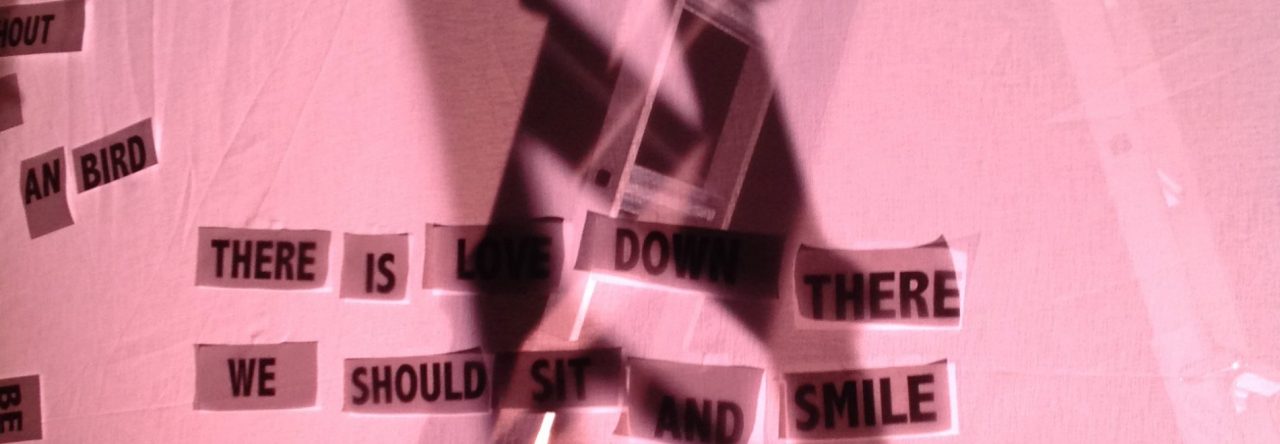by Sabrina Yu Pui Mun
In this critical reflection paper, I will be comparing two pieces of work created from two groups. The main compositional terms I will compare these two pieces under, will be of weight and texture. These terms have been selected as I feel that they were prominent features that I felt strong emotions from, but in noticeably different manners. The first piece to be discussed, was created by members Zack Faulks, Flora Jiang, Jana Ghimire and Regina Zhang.
The first piece struck me with really strong visual images that were accompanied by the hard-hitting audio that was composed and recorded by the members. I saw edited video compilations that surrounded the objects; eggs and spoons. They were captured in a way where no emotional connection could be formed between yourself and the eggs, but rather a sense of eeriness from my personal fear of the unknown. This was evident at the moment where the spoon was holding the egg, and the spoon was slowly rotating to an angle where the egg should’ve fallen and cracked, but somehow remained on the spoon; it made me feel anxious and uneasy. The composed audio accompanied the visuals really effectively, heightening the feelings of unease and anxiousness, creating the whole structure of the piece.
From start to end, I felt that the piece had a very stable growth in terms of weight. Initially, I only felt this way from the audio used in the piece, but later on, after several viewings, I felt that the visuals of the piece also managed to grow in the same manner. As an audience, sounds and images pile on top of us, all cumulative from the very beginning, with the one egg, and light background audio; surrounding sounds, and what I perceive as the peeling of an egg. Slowly but gradually, more sounds are stacked on top of one another, such as metal clinging sounds, egg cracks and other echoed noises, associated with more action to the eggs, the appearance and usage of the spoon and eventually to the combination of both the egg and spoon on screen. It made me feel like I was carrying a visual and auditory backpack but progressively with more weight placed inside of it, where first I would just feel it on the surface of my body, but as the video progresses, the weight is brought into the gut, my spine, and then the legs which support my body. Although the texture from the visuals were mostly round and soft edges; the curvature of the spoon, circular shape of the container, and elliptical shape of the egg, the texture from the sounds were so hard and rough on the edges. A visual image of the audio was created in my head, and all I saw were hard metal surfaces, with flat, sharp edges, as illustrated in Image 1.

Image 1: Drawing of audio textures from piece 1
The second piece I will be discussing and then compared with the first, was created by members Gulia Kurbanmagomedova, Jelra Ahn, and Stella Song. The second piece was significantly different in terms of structure. About half of their piece was audio-only, with a black screen accompanied. This allowed me to draw myself into the world of the audio, and to escape to wherever the sounds brought me. The mental images created were especially strong, as I became a part of the image created from the sounds. I saw views of a dock/pier from a personal, emotionally-engaging perspective, which was not present for me in the first piece. Even when the visual image appeared from about 1 minute and 10 seconds onwards, I was still in the mental world I created, but the origami boat and fish then became a part of my image. I felt very at peace with the calming sounds and imagery of waves crashing, the origami boat, the typical bell ringing at a pier. However, I also felt moments of anxiety as I was reminded of my personal fear of being in the open sea, from a traumatic experience I had when I was younger, where I had a major panic attack as I went snorkeling.
Compared to the first piece, I felt that the second maintained a consistency in weight throughout the piece. Although there was a significant change when the piece went from audio-only to audio and visual, I was able to remain in the same headspace, within the mental world that was initially created in the beginning. I did not feel like additional weight was added from the change, as well as the change in audio was consistent and lined up with my personal expectations, thus a lack of change in weight. If I were to reuse the image of an imaginary backpack, it would feel like the same three books are inside, which eventually over time, does desensitize. However, it is not negative as it creates a heightened sense of comfort and familiarity. As for texture, the second piece directly contrasts with the first. Although the visual images shown later are of origami art; with no smooth edges and only sharp, man-made corners, even on the fish, which in nature would be completely smooth, the textures I managed to feel were all smooth and flowy. In a way, both pieces managed to create the same effect in texture for their respective pieces. However, I found that really interesting as this was created primarily with the use of the audio, rather than the visual image on-screen. The flowy, smooth texture is stereotypical of the image of water and its waves, but the consistency of the sound contributed to this effect as well, where it felt like the movement of natural soundwaves, with equal wavelengths and amplitudes. If I were to draw out a visual image of the texture from the second piece, it would look like this (as shown in Image 2):

